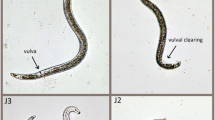Abstract
After natural desiccation in the field, anhydrobiotic populations ofPratylenchus thornei Sher & Allen andMerlinius brevidens (Allen) Sidiqqi were treated in three different ways: some were kept dry to maintain nematodes in the anhydrobiotic stage; some were rehydrated and then allowed to dry again to induce a new desiccation cycle; and some were rehydrated and maintained as such, to reactivate and keep nematodes active.P. thornei populations from the dry treatment had a greater survival rate than the two other treatments. Culturing of the nematodes under wheat revealed that the three treatments did not alter the ability ofP. thornei to penetrate the roots, but nematodes given two cycles of desiccation had a greater rate of reproduction than those exposed to one desiccation cycle and kept in dry soil for a longer period (dry treatment). Survival ofM. brevidens rehydrated and retained in the active state was lower than that of nematodes undergoing the two other treatments.
Similar content being viewed by others
References
Baujard, P. and Martiny, B. (1995) Ecology and pathogenicity of the Hoplolaimidae (Nemata) from the Sahelian zone of West Africa. 2. Laboratory studies onScutellonema cavenessi Sher.Fundam. Appl. Nematol. 18:335–345.
Demeure, Y. (1980) Biology of the plant parasitic nematodeScutellonema cavenessi Sher, 1964: anhydrobiosis.Rev. Nématol. 3: 283–289.
Glazer, I. and Orion, D. (1983) Studies on anhydrobiosis inPratylenchus thornei. J. Nematol. 15:333–338.
Oostenbrink, M. (1960) Estimating nematode populations by some selected methods,in: Sasser, J.N. and Jenkins, W.R. [Eds.] Nematology. University of North Carolina Press, Chapel Hill, NC, USA. pp. 85–102.
Perry, R.N. (1977) The effect of previous desiccation on the ability of the 4th stage larvae ofDitylenchus dipsaci to control rate of water loss and to survive drying.Parasitology 72:215–231.
Sehgal, M. and Gaur, H.S. (1988) Survival and infectivity of the reniform nematode,Rotylenchulus reniformis, in relation to moisture stress in soil without host.Indian J. Nematol. 18:49–54.
Seinhorst, J.W. (1962) On the killing, fixation and transferring to glycerine of nematodes.Nematologica 8:29–32.
Swanepoel, J.V.S. and Loots, G.C. (1992) Induced anhydrobiosis inPratylenchus zeae (Nematoda).Phytophylactica 24:193–197.
Tobar, A. (1963) The behaviour of a soil population of some plant parasitic nematodes in the processes of extraction by five different methods.Rev. Iber. Parasitol. 23:285–314.
Tobar, A., Valor, H. and Talavera, M. (1995) Kinetics of recovery from anhydrobiosis inPratylenchus thornei, Merlinius brevidens andHeterodera avenae from dry field soils and dry roots of the host plant.Fundam. Appl. Nematol. 18:21–24.
Townshend, J.L. (1984) Anhydrobiosis inPratylenchus penetrans.J. Nematol. 16:282–289.
Tsay, B.Y. and Van Gundy, S.D. (1989) Comparison of anhydrobiotic ability of the citrus nematode with other plant parasitic nematodes.Proc. 6th Int. Citrus Congr. (Tel Aviv, Israel, 1988), Vol.2, pp. 983–992.
Womersley, C. (1980) The effect of different periods of dehydration/rehydration upon the ability of second stage larvae ofAnguina tritici to survive desiccation at 0% relative humidity.Ann. Appl. Biol. 95:221–224.
Womersley, C. (1981) The effect of dehydration and rehydration on salt loss in the second stage ofAnguina tritici.Parasitology 82:411–419.
Author information
Authors and Affiliations
Corresponding author
Rights and permissions
About this article
Cite this article
Talavera, M., Valor, H. & Tobar, A. Post-anhydrobiotic viability ofpratylenchus thornei andmerlinius brevidens . Phytoparasitica 26, 293–299 (1998). https://doi.org/10.1007/BF02981443
Received:
Revised:
Issue Date:
DOI: https://doi.org/10.1007/BF02981443




